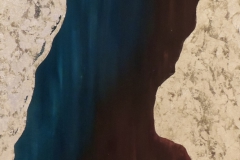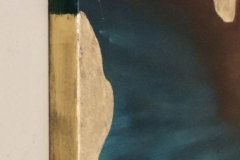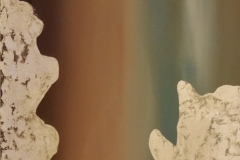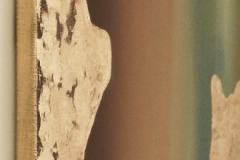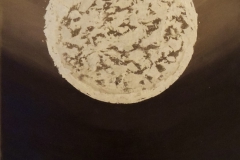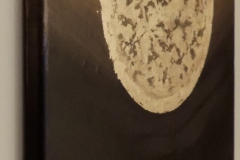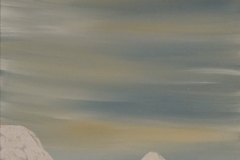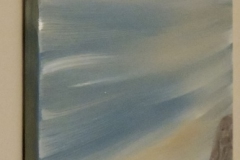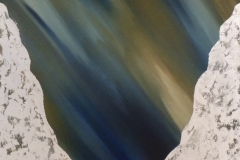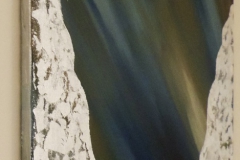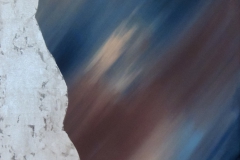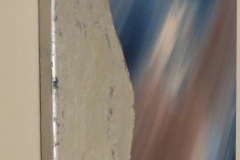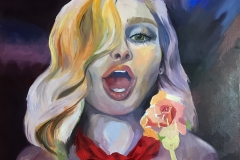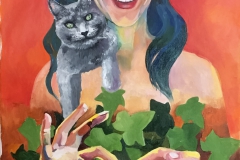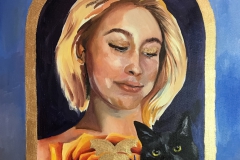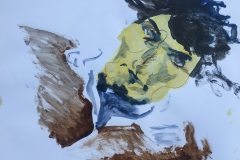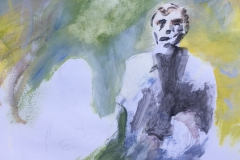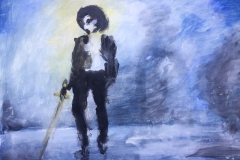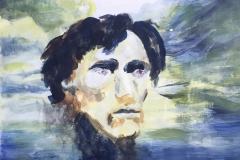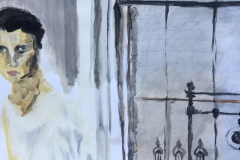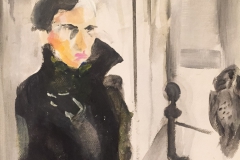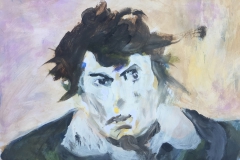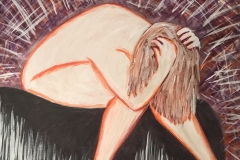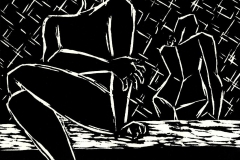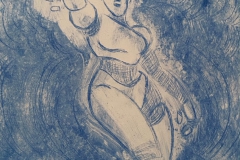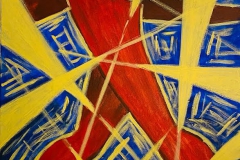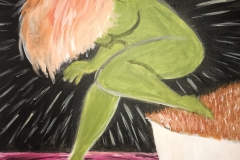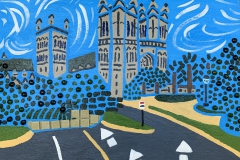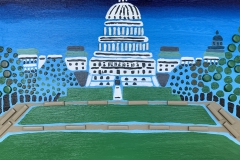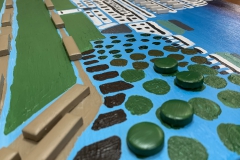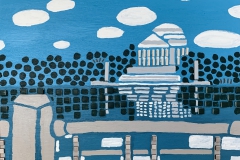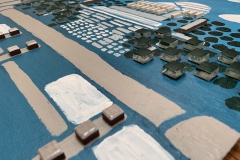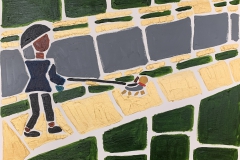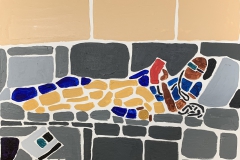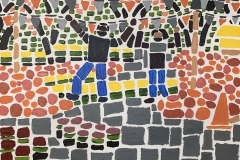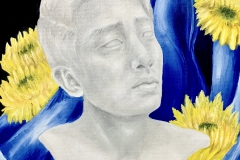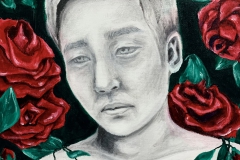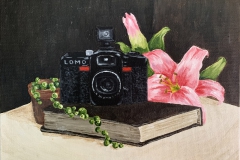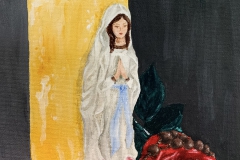2020 Art Senior Thesis Exhibition
Barry Gallery is pleased to present the 2020 Senior Thesis Online Exhibition, featuring the work of Marymount University senior students Alanoud Badeeb, Diana Dillon, Thomas Knutson, Shannon Lewandowski, Morgan Perry, and Angela Sung.
Alanoud Badeeb
Artist Statement
Colors have different spiritual values that influence human bodies and souls. Different color components produce different spiritual vibrations. Every color has its own spiritual harmony and inner meaning. Spirituality is common to humans. In my paintings, I try to connect viewers to spiritual content by exploring the relationship between colors and spirituality. My body of work is influenced by modern art movements such as abstract and non-objective art styles. Painters whose work with color and I am influenced by are Wassily Kandinsky, Hans Hofmann, and, Mark Rothko. These artists are considered essential to the history of non-objective and abstract expressionist art movements.
To my paintings, I apply gold or silver leaf because of its strong connection with my religion. I have grown up in a society that appreciates Islamic art, which is well known for gilding. In my pieces, the visual texture of the gold and silver leaf conveys the texture and senses of nature through exploring the visual and tactile qualities of nature. I work from my own photographs of nature that depict colors of nature in the sky, sea, or land. My use of color in a fluid manner shows different color combinations, the beauty of colors, and the merge of different colors. I paint the edges of my canvases in order for the viewers to look at my pieces from different angles, as if they are outdoors and observing nature from various views.
Diana Dillon
Artist Statement
My portraits focus on women who currently work in or have worked in the sex industry, as either strippers or escorts. My intention in these oil paintings is to describe a sense of strength, beauty, and empowerment, while bringing attention to societal stigmas targeted against women and female sexuality. Sex workers face discrimination and violence, with little protection or support from their gender and communities. While developing the first portrait of the set, I realized that each of these women had also lived through some form of sexual assault or abuse yet has also achieved educational and career goals.
Each model was given a variety of canvas sizes to choose from for their portraits. I found that the size choice reflects each woman’s level of self confidence, as well as individuality among the portraits. I have painted in a style influenced by religious symbolism and surreal imagery. Specific artists I have researched include Henri de Toulouse-Lautrec, Frida Kahlo, John Singer Sargent, and Nan Goldin. To prepare for each painting, I composed thumbnail designs from multiple photographic references.
As someone who has lived through assault and abuse I find familiarity with the women I’ve painted, who have learned to live with these traumas successfully, and confidently over time. Our society objectifies women and monetizes their sexuality while simultaneously stigmatizing sex workers. As a sex worker you are forced to place a value on your body, time, and energy, something a person would not normally consider. Discovering your own self worth and requiring some form of tribute for your time are ways sex workers adapt and grow, despite being a part of an exploitative industry.
Thomas Knutson
Artist Statement
My purpose in this project, which takes its impetus from the hippie culture of the 1960’s and 70s, is to support social change. I want my art to relate to values of the hippies, such as freedom, acceptance and respect, because we need more of these in current society. My use of mixed media (acrylic, watercolor, colored pencil, and pen and ink), as well as a loose, expressive style, help me to express these values.
My artwork is influenced by record album covers and concert posters of the 1960s and 70s. The figures in my pieces are also inspired by musical content. For example, I have imagined some of the people depicted as concertgoers, and, as I paint, music seems to take on color and shape. In other paintings, the figures are envisioned as counterculture activists. In the emotion of my work I am also referencing German Expressionists, particularly Egon Schiele and Emile Nolde.
Shannon Lewandowski
Artist Statement
My senior project was to visually explore how the body reacts to anxiety. As a figure drawer, dancer, and choreographer, I’ve learned how body language can be used as a powerful tool for conveying emotions. I have personally struggled with anxiety, and know many friends, family, and students who have struggled with it as well. Mental health is becoming more common in media, but it is often not brought up in everyday conversation. People are used to hiding how they feel, often telling others that ask about their well being that they’re fine. I have found that being upfront about what goes on in my mind can lead to meeting others like myself and finding ways to cope. Drawing became one of those coping mechanisms, and is the foundation for my series of paintings and prints. I wanted to use both painting and printmaking as my media, seeing as both have different advantages for conveying anxiety. With paint, I could use different color combinations and patterns that can overwhelm the viewer’s senses. With printmaking, the sketchy quality of my drawings could be easily translated into the carved lines on the woodblock. My biggest inspirations for this project were Edvard Munch, Ernst Ludwig Kirchner, Vincent Van Gogh, and Egon Schiele.
Morgan Perry
Artist Statement
The purpose of my mixed-media paintings is to express positivity through bright, bold shapes and colors during the hard times of COVID-19. My subjects include iconic locations in Washington, D.C., which are emptier in the pandemic but still inspiring, as well as images of my family engaging in activities that give us optimism and joy. With the lack of people in the first set of three paintings, the family togetherness in the second set of three paintings, and the colorful, abstract shapes in each, I show viewers that in times of COVID-19, despite negativity and despair, there are still times of positivity and hope, which can help us be strong and persevere together.
In terms of process, at first I experimented with mixed media, including acrylic paint, charcoal, colored pencil, ink, and mosaic tiles. For my final work, I settled on acrylic paint, sometimes combined with tiles. I have been influenced by such artists as Giorgio De Chirico, Stuart Davis, Wassily Kandinsky, Paul Klee, Henri Matisse, and Mickalene Thomas. In developing my subject matter, I researched articles on the pandemic’s effects on the environment and how the epidemic can be controlled through such measures as social distancing.
We have all experienced the effects of COVID-19 in many ways, physically and mentally. Our society has been feeling the negativity and darkness of the pandemic, from isolation to losing jobs, from restricted travel to the closure of cultural institutions, and from people falling ill and dying. But I want to express that through the times of COVID-19, there can still be positivity and light.
Angela Sung
Artist Statement
Le Moment is a series of portraits and still-life paintings of my fiancé and objects I value (in oil and acrylic on canvas, 11” x 14” and 8” x 10”). The purpose of this series is to reconnect with people and objects and to create new memories through the art process. In today’s world, people are busy on their cell phones, computers, and coping with daily life, forgetting to live the moment with beloved people or losing interest in the objects that once held special meaning. In addition, the current situation of the pandemic has led to separation in families and among friends who are unable to meet and spend time with each other. As a result, people are restricted from creating new memories and bonding with their loved ones. The series of artworks in Le Moment encourages viewers to recall their memories shared with their loved ones and to keep creating new memories. Most importantly, I want to remind the audience to live their lives to the fullest with their loved ones.
The subject matter of Le Moment includes my fiancé and objects that symbolize myself. In some of my works, I have incorporated both portraiture and still-life by changing my portrait subject into a bust sculpture. My subject is depicted in a sculptural figure to give more sense of importance, because historically portrait sculptures were made to honor and remember the gods or significant figures. The flowers and objects that surround the bust sculpture bear symbolic meanings that add more context to the subject, such as personal characteristics, culture, value, and mood. Artists who used symbolic meaning in their works of art who inspired me include Kehinde Wiley and Frida Kahlo. In addition, still-life painters who incorporated bust sculptures and objects that hold symbolic meaning, such as Anne Vallayer-Coster and Harmen Steenwijck, have also influenced my work.





